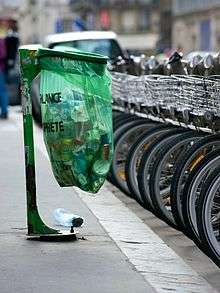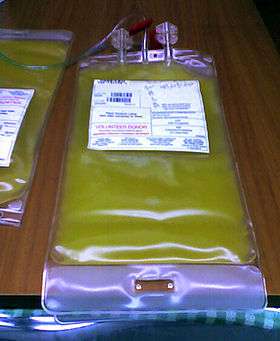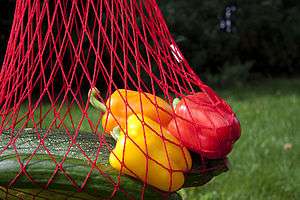Plastic bag

A plastic bag, polybag, or pouch is a type of container made of thin, flexible, plastic film, nonwoven fabric, or plastic textile. Plastic bags are used for containing and transporting goods such as foods, produce, powders, ice, magazines, chemicals, and waste. It is a common form of packaging.
Most plastic bags are heat sealed together. Some are bonded with adhesives or are stitched.
Bags
Packages
Several design options and features are available. Some bags have gussets to allow a higher volume of contents. Some have the ability to stand up on a shelf or a refrigerator. Some have easy-opening or reclosable options. Handles are cut into or added into some.
Bags can be made with a variety of plastics films. Polyethylene (LDPE, LLDPE, etc.) is the most common. Other forms, including laminates and coextrusions can be used when the physical properties are needed.
Plastic bags usually use less material than comparable to boxes, cartons, or jars, thus are often considered as "reduced or minimized packaging".[1]
Depending on the construction, plastic bags can be well suited for plastic recycling. They can be incinerated in appropriate facilities for waste-to-energy conversion. They are stable and benign in sanitary landfills.[2] If disposed of improperly, however, plastic bags can create unsightly litter and harm some types of wildlife.[3][4]
Bags are also made with carrying handles, hanging holes, tape attachments, or security features. Some bags have provisions for easy and controlled opening. Reclosable features, including press-to-seal zipper strips, are common for kitchen bags bought empty and for some foods. Some bags are sealed for tamper-evident capability, including some where the press-to-reseal feature becomes accessible only when a perforated outer seal is torn away.
Boil-in-bags are often used for sealed frozen foods, sometimes complete entrees. The bags are usually tough heat-sealed nylon or polyester to withstand the temperatures of boiling water. Some bags are porous or perforated to allow the hot water to contact the food: rice, noodles, etc.
Bag-in-box packaging is often used for liquids such as box wine and institutional sizes of other liquids.
Plastic shopping bags
Open bags with carrying handles are used in large numbers). Stores often provide them as a convenience to shoppers. Some stores charge a nominal fee for a bag. Heavy-duty reusable shopping bags are often considered environmentally better than single-use paper or plastic shopping bags.
Because of environmental and litter problems, some locations are working toward a phase-out of lightweight plastic bags.
Medical uses
Plastic bags are used for many medical purposes. The non-porous quality of plastic film means that they are useful for isolating infectious body fluids; other porous bags made of nonwoven plastics can be sterilized by gas and maintain this sterility. Bags can be made under regulated sterile manufacturing conditions, so they can be used when infection is a health risk. They are lightweight and flexible, so they can be carried by or laid next to patients without making the patient as uncomfortable as a heavy glass bottle would be. They are less expensive than re-usable options, such as glass bottles. Plastic bags and plastic wrap are also used to prevent water loss and hypothermia in very premature babies.[5]
Waste disposal bags
Flexible intermediate bulk container
Flexible intermediate bulk containers are large industrial containers, usually used for powders or flowables.
History
American and European patent applications relating to the production of plastic shopping bags can be found dating back to the early 1950s, but these refer to composite constructions with handles fixed to the bag in a secondary manufacturing process. The modern lightweight shopping bag is the invention of Swedish engineer Sten Gustaf Thulin.[6] In the early 1960s, Thulin developed a method of forming a simple one-piece bag by folding, welding and die-cutting a flat tube of plastic for the packaging company Celloplast of Norrköping, Sweden. Thulin's design produced a simple, strong bag with a high load-carrying capacity, and was patented worldwide by Celloplast in 1965.
From the mid-1980s onwards, plastic bags became common for carrying daily groceries from the store to vehicles and homes throughout the developed world. As plastic bags increasingly replaced paper bags, and as other plastic materials and products replaced glass, metal, stone, timber and other materials, a packaging materials war erupted, with plastic shopping bags at the center of highly publicized disputes.
In 1992, Sonoco Products Company of Hartsville, SC patented[7] the "self-opening polyethylene bag stack." The main innovation of this redesign is that the removal of a bag from the rack opens the next bag in the stack. This team was headed by Wade D Fletcher and Harry Wilfong.
Use of plastic bags internationally
The number of plastic bags used worldwide has been estimated to be on the order of 1 trillion annually. The use of plastic bags differs dramatically across countries. While the average consumer in China uses only 2 or 3 plastic bags a year, the numbers are much higher in most other countries: Denmark: 4, Ireland: 18, Germany: 65, USA: > 300, Poland, Hungary, Slovakia: more than 400.
Danger to children
Thin conformable plastic bags, especially dry cleaning bags, have the potential for causing suffocation. About 25 children in the United States suffocate each year due to plastic bags, almost nine out of ten of whom are under the age of one.[8] This has led to voluntary warning labels on some bags which pose a hazard to small children.[9]
Environmental issues
Non-compostable plastic bags can take centuries to decompose. In the 2000s, many stores and companies began to use different types of biodegradable bags to comply with perceived environmental benefits.[10][11]
Plastic shopping bags which escape the garbage collection process can end up in streams, which then lead them to end up in the open ocean. The way in which the bags float in open water can resemble a jellyfish, posing significant dangers to marine mammals and Leatherback sea turtles, when they are eaten by mistake and enter the animals' digestive tracts.[12] Plastic bags found on UK beaches dropped by 40% following the introduction of a 5p charge per bag.[13]
A large number of cities and counties have banned the use of plastic bags by grocery stores or introduced a minimum charge. In September 2014, California became the first state to pass a law banning their use. Local manufacturers of plastic bags, under the legislation, would receive financial support to assist them make more durable multi-use bags, that would be sold by grocery stores rather than given away, as were the plastic bags.
Uses
Plastic bags are used for diverse applications:
- Snack chips
 Gardening supplies
Gardening supplies Bagging vegetables
Bagging vegetables blood platelets
blood platelets- inner bladder for bag-in-box
 Pastry bag with convenience closure
Pastry bag with convenience closure
 Biohazard bag
Biohazard bag- Bin bag or trash bag
 String bag made of plastic fibers
String bag made of plastic fibers Multiple chambers for eventual mixing
Multiple chambers for eventual mixing- Porous bag for cooking rice
 Intravenous therapy
Intravenous therapy- Tamper evident evidence bag
_in_a_regulation_plastic_bag_(1355852892).jpg) Travel toiletries in a reclosable plastic bag
Travel toiletries in a reclosable plastic bag Woven plastic fiber bags used for sand
Woven plastic fiber bags used for sand Nonwoven plastic, geotextile bags
Nonwoven plastic, geotextile bags A plastic body bag
A plastic body bag
See also
- Biodegradable polythene film
- Biodegradation
- Bioplastic
- Box wine
- Milk bag
- Photodegradation
- Refuse-derived fuel
- Zipper storage bag
References
- ↑ "Life Cycle Inventory of Packaging Options for Shipment of Retail Mail-Order Soft Goods" (PDF). April 2004. Retrieved December 15, 2008. In June 2009 Germany’s Institute for Energy and Environmental Research concluded that oil-based plastics, especially if recycled, have a better Life-cycle Analysis than compostable plastics. They added that "The current bags made from bioplastics have less favourable environmental impact profiles than the other materials examined" and that this is due to the process of raw-material production.
- ↑ Lapidos, Juliet (2007-06-27). "Slate Explainer, 27 June 2007". Slate.com. Retrieved 2010-07-07.
- ↑ "Teresa Platt Commentary, Plastic Bags on Our Backs, May 2008". teresaplatt.com. Retrieved 2010-07-07.
- ↑ Mieszkowski, Katharine (August 10, 2007). "Plastic bags are killing us". Salon.com. Retrieved April 23, 2013.
- ↑ McCall, Emma M.; Alderdice, Fiona; Halliday, Henry L.; Jenkins, John G.; Vohra, Sunita (2010). "Interventions to prevent hypothermia at birth in preterm and/or low birthweight infants". The Cochrane Database of Systematic Reviews (3): CD004210. doi:10.1002/14651858.CD004210.pub4. PMID 20238329.
- ↑ European Plastics News: Plastic T-Shirt Carrier Bag (1965). 26 September 2008. Retrieved 17 April 2012.
- ↑ Beasley, M. Wayne; Fletcher, Wade D.; Jr, Harry B. Wilfong (Aug 9, 1994), Self-opening polyethylene bag stack and process for producing same, retrieved 2016-09-10
- ↑ Children Still Suffocating with Plastic Bags. U.S. Consumer Product Safety Commission
- ↑ "Consumer Product Safety Commission". Cpsc.gov. Retrieved 2010-07-07.
- ↑ Wilder, Sam (June 2006). "Festival food recycling: Sun, fun and diversion". BioCycle. 47 (6): 30.
- ↑ "The supermarket chain Aldi Süd of Germany is now offering its customers shopping bags made of BASF's biodegradable plastic Ecovio. (Industry News and Notes, brief article)." Plastics Engineering 65.6 (June 2009): 54(2)
- ↑ Schuyler QA, Wilcox C, Townsend K, Hardesty BD, Marshall NJ (2014). "Mistaken identity? Visual similarities of marine debris to natural prey items of sea turtles". BMC Ecol. 14: 14. doi:10.1186/1472-6785-14-14. PMC 4032385
 . PMID 24886170.
. PMID 24886170. - ↑ Conservationists herald bag tax impact on beach rubbish BBC
Further reading
| Wikimedia Commons has media related to Plastic bags. |
- Yam, K. L., "Encyclopedia of Packaging Technology", John Wiley & Sons, 2009, ISBN 978-0-470-08704-6
- Selke, S, "Packaging and the Environment", 1994, ISBN 1-56676-104-2
- Soroka, W, "Fundamentals of Packaging Technology", IoPP, 2002, ISBN 1-930268-25-4